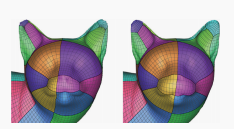Extraction of the Quad Layout of a Triangle Mesh Guided by Its Curve Skeleton
简介
论文简单构述了一个主题,输入三角网格,根据三角网格的骨架信息得到四边形网格
流程步骤
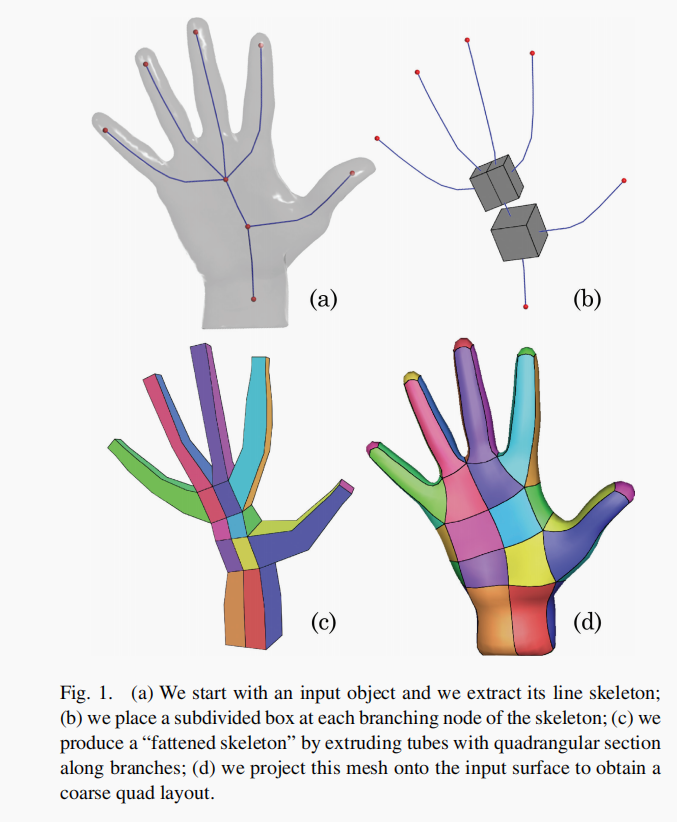
TIPS:
注意红色节点是分支节点和边节点,但是之间其实还是有一部分的折线,逻辑上也是一种节点。这种节点采用的直线的切平面构建的“四边形部分”;
Step 1: 输入三角网格,我们提取他的骨架结构信息
Step 2: 我们放置了一个细分盒子在每一个分支节点处。
Step 3: 我们在沿着管道(分支节点和分支节点,分支节点和边节点)在每个转折处放置一个四边形的面构成一个管道盒子(四边形部分)
Step 4: 我们投影这个网格到输入表面去获得一个粗糙的四边形输出
不足:不能构造精细的网格
作者回顾前人的做法,发现前人没有关于生成粗四边形网格的做法。
奇异点会在分支节点出产生。
基本步骤,生成分支节点六面体,使用整数线性规划方法来调整六面体的站位。
生成六面体。然后参数化将生成的面投影得到原来的面上得到四边形网格。
\begin{aligned}
Jn & = & 2 vector \\
En & = & 1 vector \\
Bn & = & >= 2 vector
\end{aligned}
\right.
\]
ILP (整数线性规划问题)
对于一个cubic(立方体)输入的向量\({d_1^i,...d_{k_i}^i}\),我们搜索三个相互垂直的向量\(U_i V_i W_i\)让下面的方程有最下滑的值。
\]
因为绝对值很难进行优化,作者采用了Huang在2014年提出的论文,最小化函数当\(\epsilon \rightarrow 0\)
\]
本来想代码实现这种Ipopt的约束代码,参考了 https://www.coin-or.org/downloading/ ipopt 得在github中才能下载自带的链接可能有错误,可以看看官方给出的帮助pdf。
发现C++实现有一点点复杂。
官方自带例子
// Copyright (C) 2009 International Business Machines.
// All Rights Reserved.
// This code is published under the Eclipse Public License.
//
// $Id: TutorialCpp_main.cpp 1864 2010-12-22 19:21:02Z andreasw $
//
// Author: Andreas Waechter IBM 2009-04-02
// This file is part of the Ipopt tutorial. It is a version with
// mistakes for the C++ implemention of the coding exercise problem
// (in AMPL formulation):
//
// param n := 4;
//
// var x {1..n} <= 0, >= -1.5, := -0.5;
//
// minimize obj:
// sum{i in 1..n} (x[i]-1)^2;
//
// subject to constr {i in 2..n-1}:
// (x[i]^2+1.5*x[i]-i/n)*cos(x[i+1]) - x[i-1] = 0;
//
// The constant term "i/n" in the constraint is supposed to be input data
//
#include <cstdio>
#include "IpIpoptApplication.hpp"
#include "TutorialCpp_nlp.hpp"
using namespace Ipopt;
int main(int argv, char* argc[])
{
// Set the data:
// Number of variables
Index N = 5; //100;
// constant terms in the constraints
Number* a = new double[N-2];
for (Index i=0; i<N-2; i++) {
a[i] = (double(i+2))/(double)N;
}
// Create a new instance of your nlp
// (use a SmartPtr, not raw)
SmartPtr<TNLP> mynlp = new TutorialCpp_NLP(N, a);
// Create a new instance of IpoptApplication
// (use a SmartPtr, not raw)
SmartPtr<IpoptApplication> app = new IpoptApplication();
// Change some options
// Note: The following choices are only examples, they might not be
// suitable for your optimization problem.
app->Options()->SetNumericValue("tol", 1e-10);
app->Options()->SetStringValue("mu_strategy", "adaptive");
// Intialize the IpoptApplication and process the options
app->Initialize();
// Ask Ipopt to solve the problem
ApplicationReturnStatus status = app->OptimizeTNLP(mynlp);
if (status == Solve_Succeeded) {
printf("\n\n*** The problem solved!\n");
}
else {
printf("\n\n*** The problem FAILED!\n");
}
// As the SmartPtrs go out of scope, the reference count
// will be decremented and the objects will automatically
// be deleted.
// However, we created the Number array for a here and have to delete it
delete [] a;
return (int) status;
}
// Copyright (C) 2009 International Business Machines.
// All Rights Reserved.
// This code is published under the Eclipse Public License.
//
// $Id: TutorialCpp_nlp.hpp 1864 2010-12-22 19:21:02Z andreasw $
//
// Author: Andreas Waechter IBM 2009-04-02
// This file is part of the Ipopt tutorial. It is a version with
// mistakes for the C++ implemention of the coding exercise problem
// (in AMPL formulation):
//
// param n := 4;
//
// var x {1..n} <= 0, >= -1.5, := -0.5;
//
// minimize obj:
// sum{i in 1..n} (x[i]-1)^2;
//
// subject to constr {i in 2..n-1}:
// (x[i]^2+1.5*x[i]-i/n)*cos(x[i+1]) - x[i-1] = 0;
//
// The constant term "i/n" in the constraint is supposed to be input data
//
#ifndef __TUTORIALCPP_NLP_HPP__
#define __TUTORIALCPP_NLP_HPP__
#include "IpTNLP.hpp"
using namespace Ipopt;
// This inherits from Ipopt's TNLP
class TutorialCpp_NLP : public TNLP
{
public:
/** constructor that takes in problem data */
TutorialCpp_NLP(Index N, const Number* a);
/** default destructor */
virtual ~TutorialCpp_NLP();
/**@name Overloaded from TNLP */
//@{
/** Method to return some info about the nlp */
virtual bool get_nlp_info(Index& n, Index& m, Index& nnz_jac_g,
Index& nnz_h_lag, IndexStyleEnum& index_style);
/** Method to return the bounds for my problem */
virtual bool get_bounds_info(Index n, Number* x_l, Number* x_u,
Index m, Number* g_l, Number* g_u);
/** Method to return the starting point for the algorithm */
virtual bool get_starting_point(Index n, bool init_x, Number* x,
bool init_z, Number* z_L, Number* z_U,
Index m, bool init_lambda,
Number* lambda);
/** Method to return the objective value */
virtual bool eval_f(Index n, const Number* x, bool new_x, Number& obj_value);
/** Method to return the gradient of the objective */
virtual bool eval_grad_f(Index n, const Number* x, bool new_x, Number* grad_f);
/** Method to return the constraint residuals */
virtual bool eval_g(Index n, const Number* x, bool new_x, Index m, Number* g);
/** Method to return:
* 1) The structure of the jacobian (if "values" is NULL)
* 2) The values of the jacobian (if "values" is not NULL)
*/
virtual bool eval_jac_g(Index n, const Number* x, bool new_x,
Index m, Index nele_jac, Index* iRow, Index *jCol,
Number* values);
/** Method to return:
* 1) The structure of the hessian of the lagrangian (if "values" is NULL)
* 2) The values of the hessian of the lagrangian (if "values" is not NULL)
*/
virtual bool eval_h(Index n, const Number* x, bool new_x,
Number obj_factor, Index m, const Number* lambda,
bool new_lambda, Index nele_hess, Index* iRow,
Index* jCol, Number* values);
//@}
/** @name Solution Methods */
//@{
/** This method is called when the algorithm is complete so the TNLP can store/write the solution */
virtual void finalize_solution(SolverReturn status,
Index n, const Number* x, const Number* z_L, const Number* z_U,
Index m, const Number* g, const Number* lambda,
Number obj_value,
const IpoptData* ip_data,
IpoptCalculatedQuantities* ip_cq);
//@}
private:
/**@name Methods to block default compiler methods.
* The compiler automatically generates the following three methods.
* Since the default compiler implementation is generally not what
* you want (for all but the most simple classes), we usually
* put the declarations of these methods in the private section
* and never implement them. This prevents the compiler from
* implementing an incorrect "default" behavior without us
* knowing. (See Scott Meyers book, "Effective C++")
*
*/
//@{
TutorialCpp_NLP();
TutorialCpp_NLP(const TutorialCpp_NLP&);
TutorialCpp_NLP& operator=(const TutorialCpp_NLP&);
//@}
/** @name NLP data */
//@{
/** Number of variables */
Index N_;
/** Value of constants in constraints */
Number* a_;
//@}
};
#endif
// Copyright (C) 2009 International Business Machines.
// All Rights Reserved.
// This code is published under the Eclipse Public License.
//
// $Id: TutorialCpp_nlp.cpp 1864 2010-12-22 19:21:02Z andreasw $
//
// Author: Andreas Waechter IBM 2009-04-02
// This file is part of the Ipopt tutorial. It is a version with
// mistakes for the C++ implemention of the coding exercise problem
// (in AMPL formulation):
//
// param n := 4;
//
// var x {1..n} <= 0, >= -1.5, := -0.5;
//
// minimize obj:
// sum{i in 1..n} (x[i]-1)^2;
//
// subject to constr {i in 2..n-1}:
// (x[i]^2+1.5*x[i]-i/n)*cos(x[i+1]) - x[i-1] = 0;
//
// The constant term "i/n" in the constraint is supposed to be input data
//
#include "TutorialCpp_nlp.hpp"
#include <cstdio>
// We use sin and cos
#include <cmath>
using namespace Ipopt;
// constructor
TutorialCpp_NLP::TutorialCpp_NLP(Index N, const Number* a)
:
N_(N)
{
// Copy the values for the constants appearing in the constraints
a_ = new Number[N_-2];
for (Index i=0; i<N_-2; i++) {
a_[i] = a[i];
}
}
//destructor
TutorialCpp_NLP::~TutorialCpp_NLP()
{
// make sure we delete everything we allocated
delete [] a_;
}
// returns the size of the problem
bool TutorialCpp_NLP::get_nlp_info(Index& n, Index& m, Index& nnz_jac_g,
Index& nnz_h_lag,
IndexStyleEnum& index_style)
{
// number of variables is given in constructor
n = N_;
// we have N_-2 constraints
m = N_-2;
// each constraint has three nonzeros
nnz_jac_g = 3*m;
// We have the full diagonal, and the first off-diagonal except for
// the first and last variable
nnz_h_lag = n + (n-2);
// use the C style indexing (0-based) for the matrices
index_style = TNLP::C_STYLE;
return true;
}
// returns the variable bounds
bool TutorialCpp_NLP::get_bounds_info(Index n, Number* x_l, Number* x_u,
Index m, Number* g_l, Number* g_u)
{
// here, the n and m we gave IPOPT in get_nlp_info are passed back to us.
// If desired, we could assert to make sure they are what we think they are.
assert(n == N_);
assert(m == N_-2);
// the variables have lower bounds of -1.5
for (Index i=0; i<n; i++) {
x_l[i] = -1.5;
}
// the variables have upper bounds of 0
for (Index i=0; i<n; i++) {
x_u[i] = 0.;
}
// all constraints are equality constraints with right hand side zero
for (Index j=0; j<m; j++) {
g_l[j] = g_u[j] = 0.;
}
return true;
}
// returns the initial point for the problem
bool TutorialCpp_NLP::get_starting_point(Index n, bool init_x, Number* x,
bool init_z, Number* z_L, Number* z_U,
Index m, bool init_lambda,
Number* lambda)
{
// Here, we assume we only have starting values for x, if you code
// your own NLP, you can provide starting values for the dual variables
// if you wish
assert(init_x == true);
assert(init_z == false);
assert(init_lambda == false);
// initialize to the given starting point
for (Index i=0; i<n; i++) {
x[i] = -0.5;
}
//#define skip_me
#ifdef skip_me
/* If checking derivatives, if is useful to choose different values */
for (Index i=0; i<n; i++) {
x[i] = -0.5+0.1*i/n;
}
#endif
return true;
}
// returns the value of the objective function
// sum{i in 1..n} (x[i]-1)^2;
bool TutorialCpp_NLP::eval_f(Index n, const Number* x,
bool new_x, Number& obj_value)
{
assert(n == N_);
obj_value = 0.;
for (Index i=0; i<n; i++) {
obj_value += (x[i]-1.)*(x[i]-1.);
}
return true;
}
// return the gradient of the objective function grad_{x} f(x)
bool TutorialCpp_NLP::eval_grad_f(Index n, const Number* x,
bool new_x, Number* grad_f)
{
assert(n == N_);
for (Index i=1; i<n; i++) {
grad_f[i] = 2.*(x[i]-1.);
}
return true;
}
// return the value of the constraints: g(x)
// (x[j+1]^2+1.5*x[j+1]-a[j])*cos(x[j+2]) - x[j] = 0;
bool TutorialCpp_NLP::eval_g(Index n, const Number* x,
bool new_x, Index m, Number* g)
{
assert(n == N_);
assert(m == N_-2);
for (Index j=0; j<m; j++) {
g[j] = (x[j+1]*x[j+1] + 1.5*x[j+1] -a_[j])*cos(x[j+2]) - x[j];
}
return true;
}
// return the structure or values of the jacobian
bool TutorialCpp_NLP::eval_jac_g(Index n, const Number* x, bool new_x,
Index m, Index nele_jac, Index* iRow,
Index *jCol, Number* values)
{
if (values == NULL) {
// return the structure of the jacobian
Index inz = 0;
for (Index j=0; j<m; j++) {
iRow[inz] = j;
jCol[inz] = j;
inz++;
iRow[inz] = j;
jCol[inz] = j+1;
inz++;
iRow[inz] = j;
jCol[inz] = j+1;
inz++;
}
// sanity check
assert(inz==nele_jac);
}
else {
// return the values of the jacobian of the constraints
Index inz = 0;
for (Index j=0; j<m; j++) {
values[inz] = 1.;
inz++;
values[inz] = (2.*x[j+1]+1.5)*cos(x[j+2]);
inz++;
values[inz] = -(x[j+1]*x[j+1] + 1.5*x[j+1] -a_[j])*sin(x[j+2]);
inz++;
}
// sanity check
assert(inz==nele_jac);
}
return true;
}
//return the structure or values of the hessian
bool TutorialCpp_NLP::eval_h(Index n, const Number* x, bool new_x,
Number obj_factor, Index m, const Number* lambda,
bool new_lambda, Index nele_hess, Index* iRow,
Index* jCol, Number* values)
{
if (values == NULL) {
Index inz = 0;
// First variable has only a diagonal entry
iRow[inz] = 0;
jCol[inz] = 0;
inz++;
// Next ones have first off-diagonal and diagonal
for (Index i=1; i<n-1; i++) {
iRow[inz] = i;
jCol[inz] = i;
inz++;
iRow[inz] = i;
jCol[inz] = i+1;
inz++;
}
// Last variable has only a diagonal entry
iRow[inz] = n-2;
jCol[inz] = n-2;
inz++;
assert(inz == nele_hess);
}
else {
// return the values. This is a symmetric matrix, fill the upper right
// triangle only
Index inz = 0;
// Diagonal entry for first variable
values[inz] = obj_factor*2.;
inz++;
for (Index i=1; i<n-1; i++) {
values[inz] = obj_factor*2. + lambda[i-1]*2.*cos(x[i+1]);
if (i>1) {
values[inz] -= lambda[i-2]*(x[i]*x[i] + 1.5*x[i-1] -a_[i-2])*cos(x[i]);
}
inz++;
values[inz] = -lambda[i-1]*(2.*x[i]+1.5)*sin(x[i+1]);
inz++;
}
values[inz] = obj_factor*2.;
values[inz] -= lambda[n-3]*(x[n-1]*x[n-1] + 1.5*x[n-2] -a_[n-3])*cos(x[n-1]);
inz++;
assert(inz == nele_hess);
}
return true;
}
void TutorialCpp_NLP::finalize_solution(SolverReturn status,
Index n, const Number* x,
const Number* z_L, const Number* z_U,
Index m, const Number* g,
const Number* lambda,
Number obj_value,
const IpoptData* ip_data,
IpoptCalculatedQuantities* ip_cq)
{
// here is where we would store the solution to variables, or write
// to a file, etc so we could use the solution.
printf("\nWriting solution file solution.txt\n");
FILE* fp = fopen("solution.txt", "w");
// For this example, we write the solution to the console
fprintf(fp, "\n\nSolution of the primal variables, x\n");
for (Index i=0; i<n; i++) {
fprintf(fp, "x[%d] = %e\n", i, x[i]);
}
fprintf(fp, "\n\nSolution of the bound multipliers, z_L and z_U\n");
for (Index i=0; i<n; i++) {
fprintf(fp, "z_L[%d] = %e\n", i, z_L[i]);
}
for (Index i=0; i<n; i++) {
fprintf(fp, "z_U[%d] = %e\n", i, z_U[i]);
}
fprintf(fp, "\n\nObjective value\n");
fprintf(fp, "f(x*) = %e\n", obj_value);
fclose(fp);
}
中间我看了一下代码用到了求导相关代码的编写。虽然速度很快运行结束。
JN的放置规则
JN是一个四边形的面,他的垂直部分的管道几乎和骨架平行。他垂直于两条入射弧度的平均方向。
BN-EN
因为EN是端点,随意放置规则比较简单,直接沿着Bn的面传播即可
BN-BN。
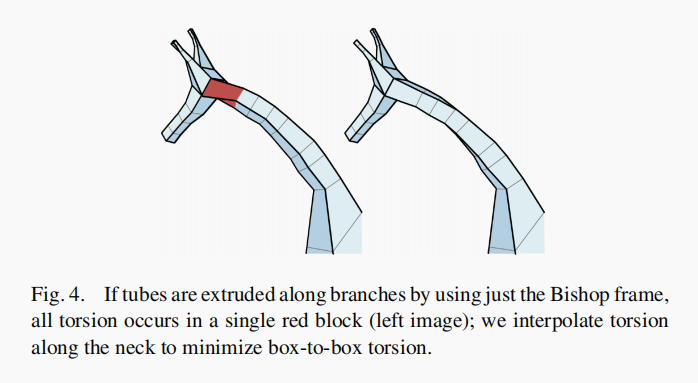
如图所示,红色的四边形是直接扭转,但是右边的图形看起来好很多因为加入了面对面的插值扭转。
因为是对应着两个面所以,中间所插入的四边形JN需要设定一定插值扭转
分裂传递
对于每个BN和EN采用防止cube 的方案,总所周知切分一个正方体有对上面有两种切法,横着切竖着切,对于侧面有一种切法,横着切(侧面的竖着切由上面实现)。
对于中间的JN有两种切法横着切和竖着切。
3n * 2m // n表示分支节点和终端节点的个数,m表示管道节点的个数,总共的未知变量就是此公式
简单来说构建一个整数线性规划问题。但是具体我不是特别清楚如何构建。
作者讲述了对于一个BN,那么将每一个面构造两个主方向U和V。然后管道和BN相遇之后我们需要将BN细分就是保持拓扑一致。
感觉有点麻烦。可以用编程简单实现而不用构造一个ILP方程。虽然编程也不容易实现。
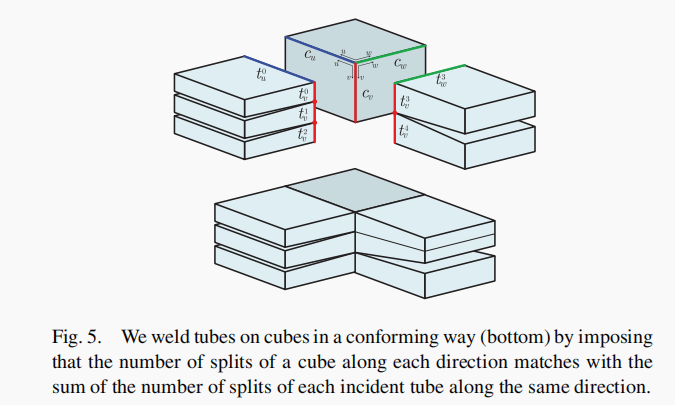
观图易知对于CUBE有三个变量分别是UVW方向上的线段切分数量和切分点而管道只有两个变量UV。
C_{u}=t_{u}^{0}=t_{u}^{1}=t_{u}^{2} \\
C_{v}=t_{v}^{0}+t_{v}^{1}+t_{v}^{2}
\end{array}\right.
\]
C_{v}=t_{v}^{3}+t_{v}^{4} \\
C_{w}=t_{w}^{3}=t_{w}^{4}
\end{array}\right.
\]
具体如何构建方程我不是特别清楚,如果谁知道麻烦在下面留言
\operatorname{argmin} \mathbf{1}^{T} X \\
\qquad \begin{array}{l}
A X=0 \\
X \geq \mathbf{1}
\end{array}
\end{array}
\]
障碍
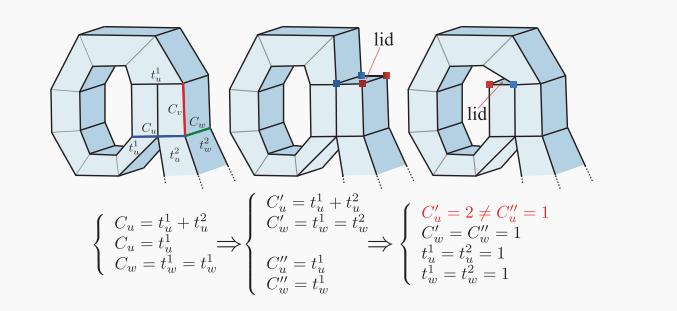
可以从图中看出对于第一个图,采用编程方案可能导致循环分裂,作者通过人为或者编程(没细看)破解了这种循环。
粗四边形网格和映射
\(\mathcal{M}\) 表示初始的三角网格
\(\mathcal{Q}\) 表示粗四边形网格
节点boxes(盒子)的大小是中心点到M内切球半径的大小。
初始化投影
将Q的每个顶点沿着Q的面法向投影到M,选择M中离Q的投影点最近的点作为映射
细分
将Q进行CC细分,然后每个点按照之前的方式投影到M上。
逆投影
M中的点也投影到Q中
通过参数化的手段优化顶点的位置,具体没有看的特别懂,如果要懂可能要看相关的作者所引用的论文了。
提出了什么共形能量,但是没有看懂。
Resizing
没看懂
用户交互
可以调整BN的角度XYZ方向

增加分支节点

Retouching Parameterization.
没看懂
似乎好像猫的鼻子那里出现了对称的情况。
结果展示
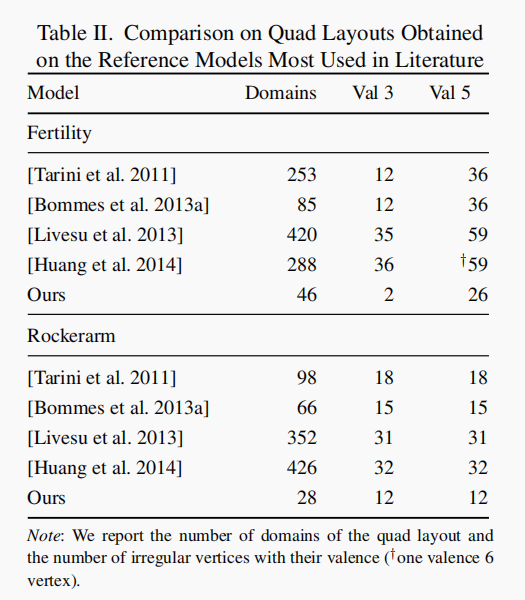
作者的方法可以生成更少的主面片区域
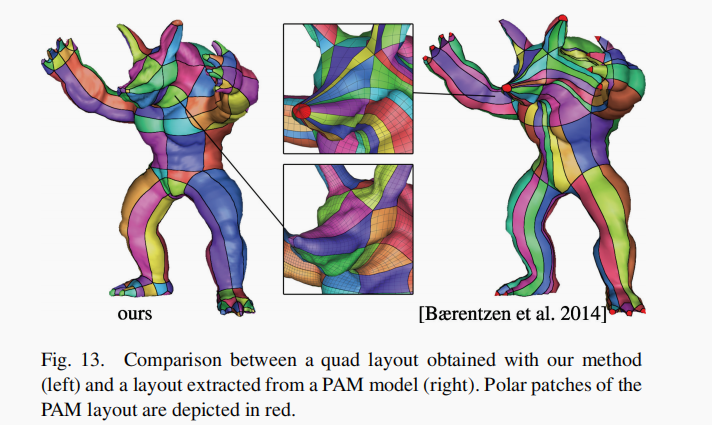
在鼻尖的展示更好
产生更小的相对标准偏差relative standard deviation (RSD)
缺点
所有不能用骨架很好的描述的模型,都不能够生成,比如杯子的空腔。
未来的工作
可以通过调整骨架节点来实现对模型的调整。
可以生成六面体网格。
为交叉参数化提供了基础,这可以用于动画的目的。
当前生成的骨架,但是并没有语义化骨架信息,比如给出一个大象的大腿。
参数化不是特别懂哭
Extraction of the Quad Layout of a Triangle Mesh Guided by Its Curve Skeleton的更多相关文章
- 三角网格(Triangle Mesh)的理解
最简单的情形,多边形网格不过是一个多边形列表:三角网格就是全部由三角形组成的多边形网格.多边形和三角网格在图形学和建模中广泛使用,用来模拟复杂物体的表面,如建筑.车辆.人体,当然还有茶壶等.图14.1 ...
- ray与triangle/quad求交二三事
引擎中,ray与quad求交,算法未细看,但有求解二次方程,不解.ray与triangle求交,使用的是97年经典算法,仔细看过论文,多谢小武同学指点,用到了克拉默法则求解线性方程组.想模仿该方法,做 ...
- Boolean operations between triangle meshes
Boolean operations between triangle meshes eryar@163.com Abstract. Boolean operations is one of basi ...
- Computer Graphics Research Software
Computer Graphics Research Software Helping you avoid re-inventing the wheel since 2009! Last update ...
- PS网页设计教程XXX——在PS中创建一个漫画书主题网页布局
作为编码者,美工基础是偏弱的.我们可以参考一些成熟的网页PS教程,提高自身的设计能力.套用一句话,“熟读唐诗三百首,不会作诗也会吟”. 本系列的教程来源于网上的PS教程,都是国外的,全英文的.本人尝试 ...
- C#代码创建3D模型
Demo 1:创建三角形 示例代码 构建一个只包含单个三角形及纹理坐标的网格 using UnityEngine; using System.Collections; public class Mes ...
- A trip through the Graphics Pipeline 2011_03
At this point, we’ve sent draw calls down from our app all the way through various driver layers and ...
- Gazebo機器人仿真學習探索筆記(三)機器人模型
gazebo_models:https://bitbucket.org/osrf/gazebo_models 模型庫下載,可以參考如下命令: ~/Rob_Soft/Gazebo7$ hg clone ...
- Foundations of Game Engine Development Volume 1 Mathematics (Eric Lengyel 著)
http://www.foundationsofgameenginedev.com/ Chapter1 Vectors and Matrices (已看) Chapter2 Transforms (已 ...
- Unity3D之Mesh(四)绘制多边形
来自https://www.cnblogs.com/JLZT1223/p/6086191.html 1. 总的来说绘制平面的思想十分简单,就是将需要的平面拆分成几个三角形然后进行绘制就可以啦,主要的思 ...
随机推荐
- 基于华为交换机的三层Clos架构(Leaf-Spine)配置指南
基于华为交换机的三层Clos架构(Leaf-Spine)配置指南 目录 设计原则 配置步骤 物理连接与基础配置 路由协议配置 VXLAN+EVPN配置 M-LAG高可用配置 BFD快速检测 验证命令 ...
- UT
Mockito 官网 注解
- kette介绍-Step之Table output
表输入(Table output)介绍: Table output步骤常被用于将转换中的行集从内存持久化到数据库,对转换而言是 行集被拿出去的感觉,故名为输出.可以限制提交记录数量和指定插入的目标表 ...
- PyQt6安装与配置(附带Vscode配置)
1. 安装PyQt6和PyQt-tools pip install PyQt6 pip install PyQt6-tools 2. Vscode配置QtDesigner 安装PyQt Integra ...
- rider的xamarin环境安装
自从用上rider后,vs就再也没有安装过了.最近要做apk开发,就安装xamarin环境,但是总是报错: Show Log->idea.log 发现下面错误: ERROR | Environm ...
- 【经验】Word 2021|如何在Word里做出和Markdown中一样漂亮的引用样式(结尾附成品)
文章目录 写在最前 方法以及参数 1 打开样式窗口 2 设置一些基本操作 3 打开格式窗口 4 修改样式 最后一步!保持间隔 成品的介绍(一些自卖自夸)+获取链接(不想看做法的话直接下载) 写在最前 ...
- vue3 基础-自定义指令 directive
上篇内容是关于 mixin 混入的一些操作, 也是关于代码复用层面的, 本篇讲自定义指令 directive 也是为了实现复用而设计的一些小功能啦. 先来看看, 如果不用 directive 的场景下 ...
- C#/.NET/.NET Core技术前沿周刊 | 第 39 期(2025年5.19-5.25)
前言 C#/.NET/.NET Core技术前沿周刊,你的每周技术指南针!记录.追踪C#/.NET/.NET Core领域.生态的每周最新.最实用.最有价值的技术文章.社区动态.优质项目和学习资源等. ...
- MySQL设置字符集、排序规则和区分字母大小
摘要:在MySQL中,设置字符集和排序规则,在查询时区分字母大小写,utf8mb4支持emoji表情,而utf8不支持. 问题综述 在工作中,设置的一些唯一标志字符串和登录密码都是区分大小写的,但 ...
- Client-go的四种客户端的简单使用
Client-go的四种客户端使用 我们知道kubectl是通过命令行交互的方式与Kubernetes API Server进行交互的,Kubernetes还提供了通过编程的方式与Kubernetes ...

